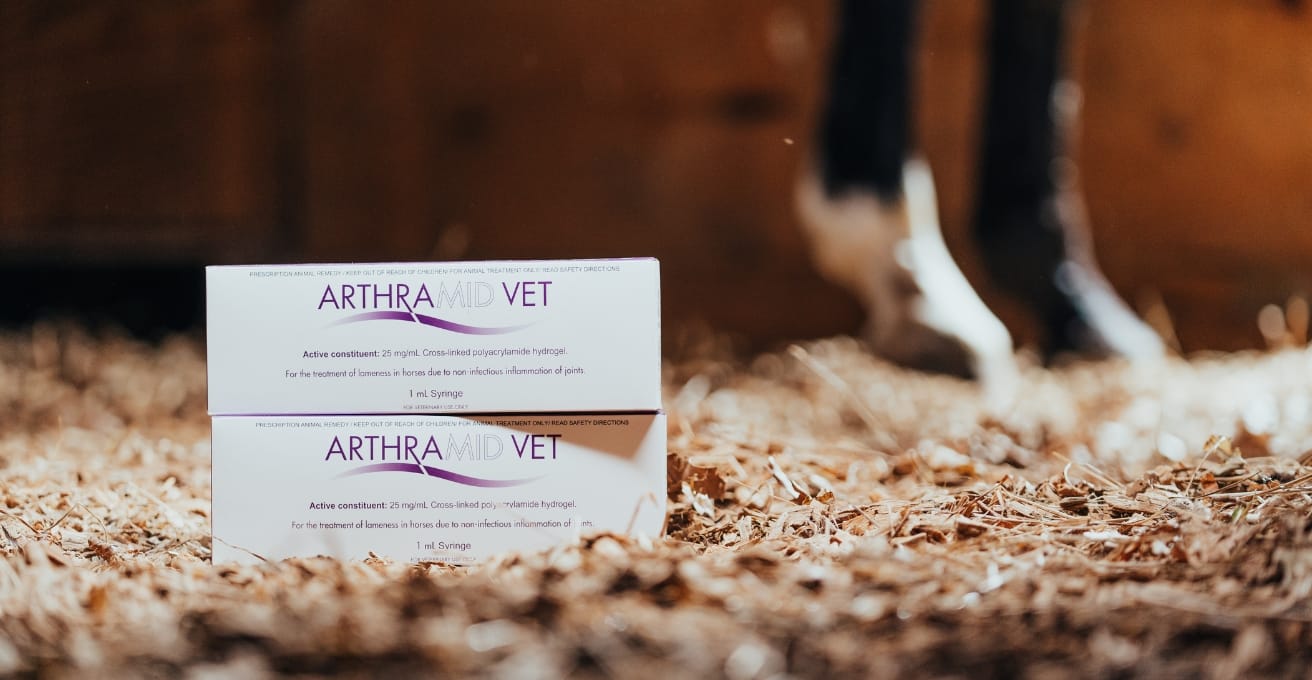Treating joint diseases such as osteoarthritis (OA) presents a significant challenge in veterinary medicine – both in horses and companion animals. Conventional therapies such as corticosteroids, hyaluronic acid, polysulfated glycosminoglycans (PSGAGs), non-steroidal anti-inflammatory drugs (NSAIDs), and any combination of the above, along with biological substances and now anti-nerve growth factor monoclonal antibodies (Bedinvetmap) injections are widely used, particularly for their ability to reduce inflammation and relieve pain. However, these methods are increasingly known to be associated with difficulties in administration or even complications and their use is being restricted across certain populations. The ideal therapeutic agent for treating OA is one that alleviates the symptoms of lameness while also providing positive effects on the articular components of the joint, resulting in a stabilisation or even repair of the pathologic processes occurring in the effected joint.
One such promising option is Arthramid – a safe and innovative 2.5% polyacrylamide hydrogel (2.5 % iPAAG) that is injected directly into the affected joint. 2.5% iPAAG has distinct physical and biocompatible properties that make it effective in tissue applications across multiple species, particularly in synovial joints. The primary intended purpose of the hydrogel is to restore capsular elasticity. As a result, Arthramid can bring about a long- lasting improvement in joint function, particularly in cases where conventional therapies are not suitable or no longer sufficient.
Arthramid (2.5% iPAAG) is currently still undergoing EU authorisation as a veterinary medicinal product, so is not yet formally approved in the EU. However, it is already authorised for veterinary use in New Zealand, Australia, and the United States. Importantly, its use is still possible in Europe under specific conditions – thanks to the so-called cascade regulation. This legal framework allows veterinarians to use non-EU-authorised products in exceptional cases, for example when approved alternatives are not sufficiently effective.
Importantly, Arthramid is already manufactured within the EU, in compliance with all relevant regulatory standards. Production follows Good Manufacturing Practice (GMP) guidelines, and distribution as an imported product is carried out exclusively through certified wholesalers in accordance with Good Distribution Practice (GDP). As such, Arthramid already meets many of the quality and safety requirements expected of EU-authorised veterinary medicinal products – a decisive factor when it is used responsibly under the cascade regulation.
The cascade regulation in the EU – a brief overview of the new regulations
The cascade regulation has been significantly modernised with the new EU Veterinary Medicinal Products Regulation (EU) 2019/6, which has been in force since 28 January 2022. It creates more clarity and flexibility for veterinarians – especially in situations where no authorised medicines are available for certain animal species or indications.
Advantages of the new cascade regulation:
• Extended application options: Vets are now allowed to use medicines that are authorised for other animal species or indications.
• Import from third countries possible: Products such as Arthramid, which are currently still authorised outside the EU (e.g. in New Zealand, Australia or the USA), may be imported and used under certain conditions.
• Clearer documentation requirements: The new regulation defines exactly when and how a medicine may be used outside of its marketing authorisation, providing legal certainty.
• Greater room for manoeuvre in the event of treatment emergencies: The regulation recognises that veterinarians need solutions in certain cases to ensure the best possible care – particularly in the case of chronic or treatment-resistant diseases. Using products like Arthramid is the responsibility of the treating veterinarian, who must individually assess whether the requirements of the cascade are met.
• Standardised EU-wide system: The regulation creates a common legal basis for all member states – this means more guidance and consistency for veterinarians in the EU. However, the individual countries still retain their own import and authorisation conditions. This means that even if a medicine such as Arthramid can generally be used via the cascade system, vets must carefully check and comply with the national requirements for import and use.
Conclusion
Arthramid (2.5% iPAAG) has emerged as a significant innovation in the treatment of OA in animals (and humans) and opens up new possibilities in the treatment of joint diseases – especially where conventional approaches reach their limits or are contraindicated. Even though the product is not (yet) regularly authorised in the EU, the cascade regulation allows it to be used responsibly under clearly defined conditions. In combination with the already EU-compliant production and distribution, Arthramid 2.5% iPAAG fulfils many of the requirements placed on modern veterinary medicinal products – and thus represents a sensible therapeutic option that offers veterinarians and animal owners alike new perspectives.
Contact Us
For more information on availability, navigating the regulations, or finding an authorised agent in your region, visit our website www.arthramid.com/contact or contact us directly arthramid.eu@conturavet.com. Let’s work together on improving the standard of care for your patients with OA!


